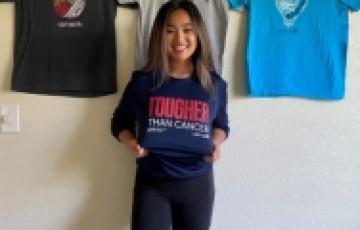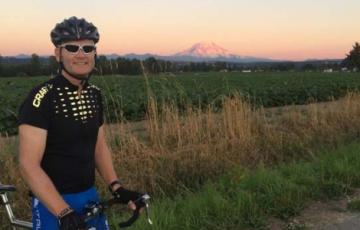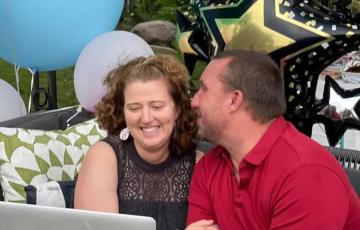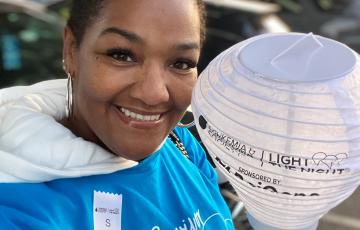Search Results

LLS Researchers
Partnering for Cures – Our Unique Collaborations Span Continents

Jeannine
I got started with The Leukemia and Lymphoma Society (LLS) when our good friend, Tim Mauro, ran for Man of the Year and my husband, Larry, was his “campaign manager.” Tim’s father-in law, Bob, was battling non Hodgkin lymphoma. Watching them battle with him and seeing everything they did to help was such an inspiration, and seeing how many people were bonded together, raising money to find a cure, was amazing.

Madeline
My daughter is Madeline Conley. On January 7, 2014, three days after her 15th birthday, she was diagnosed with leukemia (AML/MDS). She was a high school cheerleader and cheer coach who was basically ripped out of her normal active life and immediately admitted to the hospital, where she spent the next five months. It was the scariest thing we've ever been through.

Mia
As Mia started her third grade year at elementary school she began complaining of pain in her legs. At first, her mom just thought it was normal growing pains. But then Mia started sleeping a lot more, lost her appetite and just didn’t have her normal level of energy. Mia’s parents, Alma and Ernesto, decided it was time to take her to the doctor.

Starlet
When I was born, I was healthy and hardly ever got sick. Well, when I turned one, I had fevers that would come and go and then my mom started to notice I would limp and bruise easily. My mom decided to take me to the hospital after a persistent fever and the limping and bruising got worse. The doctors then referred us to Valley Children’s where they did blood work on me.
After the results came in my parents heard the words no one ever wants to hear: their one-year-old daughter is now diagnosed with acute myeloid leukemia (AML).

Lillian & Jerry
In 2011, our son, Jerry, was diagnosed with acute myeloid leukemia (AML) at three years old, and he has gone through two bone marrow transplants. Though he has been in remission since 2014, he has developed many other diseases due to the treatment and drugs, such as kidney failure, low vision, a compromised immune system, and heart issues. While Jerry was going through cancer treatment, his little sister, Lillian, was born and grew up to be a vibrant and sweet girl. Yet, in an unimaginable twist of fate, the same devastating cancer diagnosis shattered our hope.

Halimeh
On June 3, 2014, I went to my local hospital for blood work after noticing unexplained bruising and nose bleed. That day changed my life forever.

Susanne
I am a four-time diffuse large B-cell lymphoma (DLBCL) survivor and a recent stem cell transplant (SCT) survivor. DLBCL is a type of non-Hodgkin lymphoma (NHL). My first diagnosis was in 2007, then 2012, 2013, and 2023. I received invaluable support financially from The Leukemia & Lymphoma Society (LLS). People often ask how I am so positive after all I've been through. I think we need to take whatever we are dealt and make the best of it each day. The key is a positive attitude, gratitude, and a strong support system.

John
I've been a cancer survivor since my bone marrow transplant at Seattle Cancer Care Alliance in 2004. I have minimal side effects and continue doing what I love -- spending time with family and friends, cycling, and teaching high school photography and video production. One year after my transplant I did my first Team In Training event, a century ride in Lake Tahoe. I continued to do four more events. My high school video students put on a film festival every year to support the Northwest Chapter of The Leukemia and Lymphoma Society.

Bonnie
My dad, Larry Vogl, was diagnosed with leukemia out of the blue in November 2014. In the picture, he is with my three boys and my nephew (his four grandsons). They are the reason for the fight!
I am also the oldest of six kids, and my dad has always done and will always do anything for us - putting his kids first.
He is my inspiration for running, yet, my journey seems to pale in comparison to his. I look forward to sharing the Team In Training miles with my youngest sister Jamie, and representing our whole family in honor of our dad.
Gisenia
In October 2015, Gisenia Reyes heard the words "You have cancer." Diagnosed with acute myeloid leukemia (AML), an aggressive type of blood cancer. She immediately underwent chemotherapy treatment to save her life.
Gisenia attained remission status, however, she still had a mutation in her blood work, which could cause her to relapse.
Carson
In October 2016, after a few months of asymptomatic fevers, joint pain, and extreme irritability Carson was admitted to the University of Virginia Children's Hospital in Charlottesville, Virginia where she was diagnosed with acute lymphoblastic leukemia (ALL).

Amanda
Amanda was a Woman of the Year candidate this past spring, raising over $186,000 for The Leukemia & Lymphoma Society (LLS).
She is a multiple myeloma (MM) survivor and just received the newly approved for MM, CAR-T cell treatment, 5 days before the fundraising campaign finale.
LLS first met Amanda when she was pushed through the front doors of the office in her local region, in a wheelchair.

Matthew
Matthew was diagnosed with Burkitt's Lymphoma and Leukemia in November 2008 at just two years old. After long and difficult chemotherapy treatments, Matthew achieved remission. He is now part of The Children's Hospital of Philadelphia survivorship program. Matthew finds time for his hobbies like making crafts and running make-believe restaurants and stores. He also stays busy playing baseball, swimming, and basketball. Matthew also enjoys looking for treasure in his backyard. When he grows up, Matthew wants to be a teacher or a restaurant owner because he loves people.

Addison
Florida is my happy place. It's where I've vacationed for over three decades. And when my husband and I had kids, it became our family's happy place too. Schedules are forbidden on vacation. We tell time by the sun as we sit on the beach with our feet in the sand, watching the tide roll in and out. While on vacation, we celebrate birthdays ― and they're done up big ― because that's the only way that we know how to celebrate birthdays ― BIG.

Aiden
On November 6, 2022, God spoke to me and told me to take Aiden to the hospital. He had a lingering cough and random fevers that would come and go over the month. I took my parents to Philly airport and stopped by Nemours in Wilmington. I figured they would run some tests, and I would be told he had some infection. We would get medications and be on our way. When the nurse examined him, she asked about anything else going on. I mentioned he has had a lot of bruising lately, but he does karate and is a typical boy. We looked over his whole body, and I had not realized he had so many bruises!
Follow-Up Care
Click here for information about follow-up care, including what to expect, long-term and late effects of treatment, survivorship clinics, and other resources such as The National Comprehensive Cancer Network (NCCN) treatment guidelines.
Use the Survivorship Workbook to collect all the important information you need throughout diagnosis, treatment, follow-up care and long-term management of a blood cancer.

Charles
I was alone with my doctor in the hospital when she told me I had no bone marrow matches in the world. I cried a lot that day. I was admitted two weeks prior, after relapsing from acute myeloid leukemia (AML), an aggressive blood cancer. As a husband, father and criminal prosecutor, I’ve dedicated my life to caring for my loved ones and protecting my community. Now, leukemia was threatening my life and there was no one that could protect me from it.

Shameel
Telling a child that they have cancer and explaining what that means is one of the most difficult conversations you can have with your child.
Shameel was diagnosed with acute lymphoblastic leukemia (ALL) at age 7. As a mother, I couldn't imagine my young, courageous boy, who appeared happy and healthy, not being able to do stuff like tennis, ice skating, piano, and swimming, which he enjoyed and had mastered. It was very shocking to me, and I was in denial for almost a month as cancer does not run in our family.

Joseph
Feb 10, 2012 has forever changed our lives. Joseph was 6 years old and in his fifth month of kindergarten. Joe's journey actually began many months prior. Shortly after starting kindergarten there were ear infections, fevers, belly pain, joint swelling and bone pain. All this from a child who was always very healthy. Feb 10, 2012, the definitive diagnosis of pre-b cell acute lymphoblastic leukemia (ALL) was echoing through my head. Joe was admitted to the hospital immediately and taken to the pediatric hematology/oncology floor.

Kenya
I was diagnosed with two blood cancers — multiple myeloma (MM) and chronic myelomonocytic leukemia (CMML).
Cancer entered my life at five years old when I lost my father to pancreatic cancer. Then again, when my oldest sister was diagnosed with breast cancer, she is now nine years cancer-free. Then again, when my mother was diagnosed with breast cancer. Sadly, we lost my mother in May 2019 to breast cancer
Other Disease Studies
Another type of study that blood cancer patients and their relatives can participate in is a nontherapeutic study. Nontherapeutic studies aren't considered clinical trials because they don't involve the study of new diagnostics or treatments for diseases. Instead, they're developed to gain a better understanding of disease-incidence patterns or the consequences of specific treatments for a specific disease.
In all cases, you should be asked to sign a consent form that defines the study's purpose and what's expected from the participants.
Stem Cell Transplantation
The goal of stem cell transplantation is to cure the patient’s cancer by destroying the cancer cells in the bone marrow with high doses of chemotherapy and then replacing them with new, healthy blood-forming stem cells. The healthy blood stem cells will grow and multiply forming new bone marrow and blood cells. There are two main types of stem cell transplantation. They are
Side Effects
The side effects of treatment for essential thrombocythemia (ET) will depend on many factors, including the type of treatment and dosage, the age of the patient and coexisting medical conditions.
Management of side effects is important. Patients should discuss any concerns about side effects with their doctor. Most side effects are temporary and resolve when treatment is completed
Treatment Outcomes
Among patients with MF, the prognosis (meaning the likely outcome of the disease) varies widely. Each patient’s risk factors are evaluated individually to determine their prognosis. However, some people with MF may survive for decades following their diagnosis.
It is important to know that outcome data can show how groups of people with MF responded to treatment in the past, but it cannot always determine how any particular person will respond. For these reasons, patients are advised to discuss information about survival with their doctors.